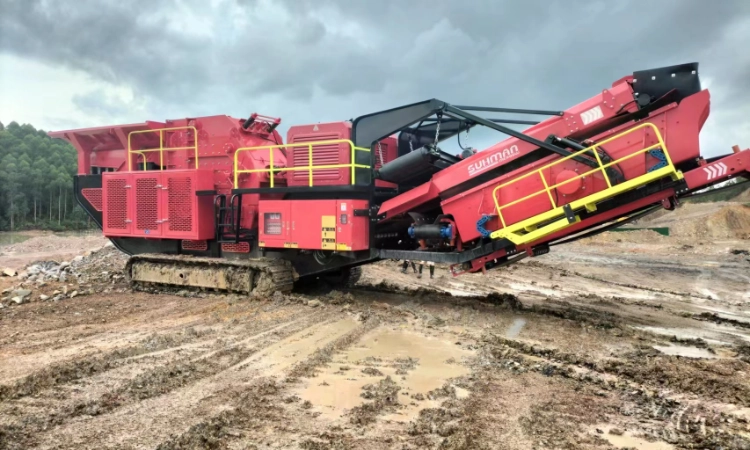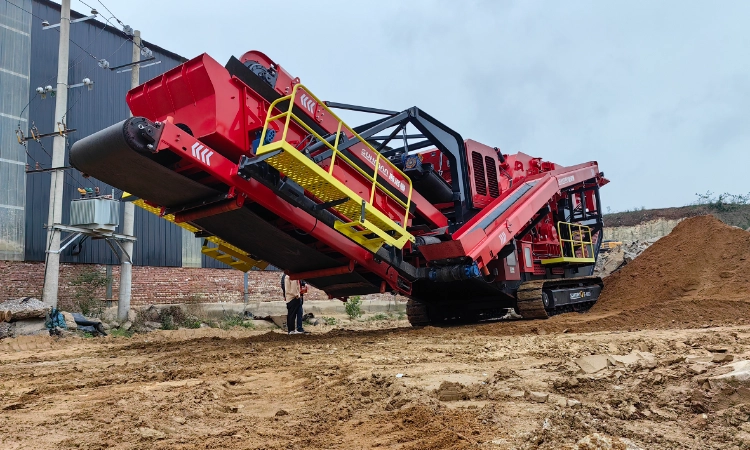What is a Crusher?
Release time: 2025-03-17
Understanding Crushers: A Comprehensive Guide to Types, Mechanisms, and Applications
Crushers are indispensable machines in industries such as mining, construction, and chemical processing. They break down large materials—like rocks, ores, or industrial waste—into smaller, manageable particles. Whether you’re processing aggregates, recycling concrete, or preparing raw materials for further use, selecting the right crusher is vital for efficiency and productivity. This guide dives deep into crusher types, their mechanisms, real-world applications, and offers practical advice on choosing the best one for your needs.
Table of Contents
- What is a Crusher?
- Types of Crushers
- How Does a Jaw Crusher Work?
- Jaw Crusher vs. Cone Crusher
- Mobile Crushing Solutions
- Crusher Comparison Table
- How to Choose the Right Crusher
- Detailed Crusher Selection Criteria
- Real-World Applications of Crushers
- Conclusion
What is a Crusher?
A crusher is a mechanical device designed to reduce large materials into smaller pieces using compression, impact, or shear forces. In industries like mining, construction, and recycling, crushers play a pivotal role in material processing workflows. They can turn hard granite into transportable gravel or transform demolished concrete into reusable aggregates. Crushers vary in design based on application and material properties—some handle high-hardness rocks in quarries, while others prioritize portability and low noise for urban settings.
Types of Crushers
Crushers are classified into four main types based on their operating mechanisms: jaw crushers, cone crushers, roll crushers, and impact crushers. Each excels in specific crushing stages and material types.
Jaw Crushers
Jaw crushers are the go-to choice for primary crushing, excelling at breaking down large, hard materials. They feature a fixed jaw and a movable jaw forming a V-shaped chamber where material is compressed as the movable jaw swings.
- Mechanism: Compression driven by an eccentric shaft moving the jaw.
- Design Variants:
- Blake Jaw Crusher: Fixed feed area, adjustable discharge; ideal for high-capacity primary crushing.
- Dodge Jaw Crusher: Variable feed area, fixed discharge; suited for labs or small-scale operations.
- Universal Jaw Crusher: Combines features of both for versatility.
- Applications: Crushing basalt, granite, and limestone in mining and quarrying.
- Pros: Simple, durable, excellent for coarse crushing.
- Cons: Limited to primary crushing; not suited for fine output.
Insight: Jaw crushers handle materials with compressive strengths exceeding 300 MPa. The Blake type dominates large quarries due to its high throughput, while the Dodge type fits smaller setups. Learn how jaw crushers work.
Cone Crushers
Cone crushers are used for secondary and tertiary crushing, producing finer, uniform particles by compressing material between a rotating cone and a fixed concave.
- Mechanism: Compression as the cone gyrates within a bowl-shaped chamber.
- Design Variants:
- Standard Cone Crusher: Larger feed opening for secondary crushing.
- Short-Head Cone Crusher: Smaller opening for finer tertiary output.
- Applications: Ore processing, aggregate production, and recycling.
- Pros: High output, uniform particles, great for hard materials.
- Cons: Higher cost, complex maintenance.
Insight: Standard cones handle medium-hard materials, while short-head cones, with steeper angles, produce fine aggregates for uses like asphalt production. Explore cone crusher applications.

Roll Crushers
Roll crushers compress materials between two counter-rotating rollers, making them ideal for medium to fine crushing of brittle or sticky substances. Roller surfaces can be smooth, toothed, or ridged.
- Mechanism: Compression between rollers, with the nip angle determining effectiveness.
- Design Variants:
- Smooth Roll Crusher: Fine crushing of soft materials like coal or clay.
- Toothed Roll Crusher: Harder materials like limestone.
- Applications: Coal, clay, and soft mineral crushing in cement and power industries.
- Pros: Handles wet/sticky materials, low dust, continuous operation.
- Cons: Lower capacity, uneven wear on rollers.
Insight: The nip angle (17°-30°) ensures effective gripping. Toothed rolls excel with moist materials by tearing rather than just compressing. Discover roll crusher advantages.
Impact Crushers
Impact crushers use high-speed impacts to shatter materials, producing high-quality cubical aggregates across various crushing stages.
- Mechanism: Material is struck by rotating hammers or bars and thrown against breaker plates.
- Design Variants:
- Horizontal Shaft Impact Crusher (HSI): Soft to medium-hard materials, common in recycling.
- Vertical Shaft Impact Crusher (VSI): Fine aggregates and manufactured sand.
- Applications: Limestone crushing, concrete recycling, sand production.
- Pros: High reduction ratio, great particle shape, versatile.
- Cons: Faster wear, less effective for very hard rocks.
Insight: HSI uses horizontal blows for larger feeds, while VSI leverages centrifugal force for precision shaping, ideal for concrete. Learn about impact crusher benefits.

How Does a Jaw Crusher Work?
A jaw crusher feeds material into a chamber between a fixed and movable jaw. The movable jaw, powered by an eccentric shaft, swings back and forth, compressing the material against the fixed jaw. Crushed material exits the bottom, while a flywheel ensures smooth operation. This makes it ideal for primary crushing of large, hard materials. Dive into the jaw crusher working principle.
Jaw Crusher vs. Cone Crusher
Deciding between jaw and cone crushers depends on your crushing stage and output goals:
- Jaw Crusher:
- Best for primary crushing.
- Handles very hard materials (e.g., granite).
- Output: 50-300 mm.
- Simple design, easy to maintain.
- Cone Crusher:
- Best for secondary/tertiary crushing.
- Output: 5-50 mm.
- Suited for medium-hard materials.
- Higher capacity, precise adjustments needed.
Analysis: Jaw crushers excel at coarse initial processing, while cone crushers refine materials further—often used together in production lines. Compare jaw and cone crushers.
Mobile Crushing Solutions
Mobile crushers combine jaw, cone, or impact mechanisms into portable units, perfect for on-site processing in urban construction, remote quarries, or recycling projects.
- Types:
- Tracked Mobile Crusher: High mobility for rugged terrain.
- Wheeled Mobile Crusher: Easy highway transport for frequent moves.
- Advantages:
- Lower transport costs.
- Operational flexibility.
- On-site recycling reduces environmental impact.
Example: A tracked impact crusher can recycle concrete into aggregates on-site during urban demolition. Explore mobile crusher benefits.
Crusher Comparison Table
Here’s a detailed comparison of crusher types for quick reference:
| Crusher Type | Mechanism | Feed Size (mm) | Output Size (mm) | Capacity (t/h) | Power (kW) | Typical Wear Parts |
|---|---|---|---|---|---|---|
| Jaw Crusher | Compression | Up to 1,500 | 50-300 | 50-1,000 | 30-250 | Jaw plates, toggles |
| Cone Crusher | Compression | Up to 300 | 5-50 | 50-1,200 | 75-315 | Mantle, concave |
| Roll Crusher | Compression | Up to 100 | 1-20 | 10-200 | 15-75 | Roll shells, bearings |
| Impact Crusher | Impact | Up to 500 | 10-100 | 50-800 | 55-250 | Blow bars, impact plates |
Note: Values are approximate and vary by model/manufacturer.
How to Choose the Right Crusher
Selecting the right crusher involves assessing key factors:
- Material Properties: Hardness, abrasiveness, moisture, and compressive strength.
- Output Requirements: Desired particle size, shape, and production rate.
- Mobility Needs: Stationary vs. mobile based on site conditions.
- Operational Costs: Energy use, maintenance, and wear part replacement.
Detailed Crusher Selection Criteria
For a more thorough decision, consider these detailed aspects:
- Initial vs. Operating Costs: Jaw and roll crushers are cheaper upfront; cone and impact crushers excel in high-volume efficiency.
- Space Constraints: Mobile or compact units suit tight or urban spaces.
- Environmental Factors: Opt for dust suppression, low noise, and energy-efficient models in sensitive areas.
- Maintenance Needs: Jaw crushers are simpler to maintain; cone crushers demand more technical expertise.
Check our crusher selection guide for tailored advice.
Real-World Applications of Crushers
Here are some practical uses of crushers:
- Mining: Jaw crushers break large ore, followed by cone crushers for secondary crushing before grinding.
- Construction Demolition: Mobile impact crushers recycle concrete and asphalt into aggregates on-site.
- Quarrying: Roll crushers process limestone and shale for cement production.
- Sand Production: VSI impact crushers create high-quality manufactured sand for concrete and asphalt.
Discover more crusher applications.
Conclusion
Crushers are the backbone of material processing, each type offering unique strengths. From the coarse power of jaw crushers to the precision of cone and impact models, understanding their roles optimizes operations. Whether in mining, construction, or recycling, the right crusher boosts efficiency and cuts costs. For more details, explore our complete crusher guide or contact us for expert advice.


